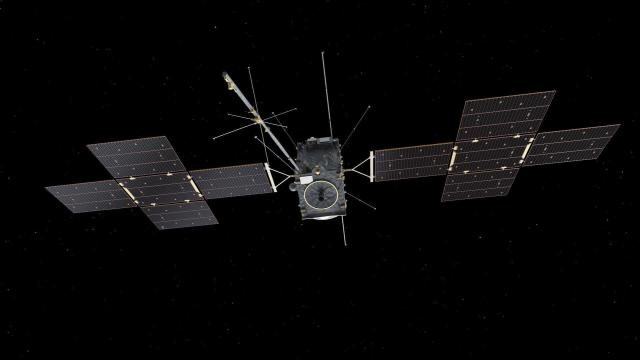It’s been six weeks since Europe’s JUICE mission launched towards the Jovian system, and the spacecraft is now all suited-up, with its instruments ready to explore the potential habitability of Jupiter’s mysterious, icy moons.
This week, the European Space Agency (ESA) announced that its JUpiter ICy moons Explorer, or JUICE for short, has fully deployed its solar panels, antennas, probes and booms. The spacecraft’s various instruments were safely tucked away to fit into the Ariane 5 rocket that launched it to space, but have now unfurled to reveal JUICE in its full glory.
“It’s been an exhausting but very exciting six weeks,” Angela Dietz, deputy spacecraft operations manager for the mission, said in the ESA statement. “We have faced and overcome various challenges to get [JUICE] into the right shape for getting the best science out of its trip to Jupiter.”
JUICE launched on April 14 on a 12-year mission to study three of Jupiter’s icy moons: Europa, Ganymede, and Callisto. All three moons may have subsurface oceans of water, which could hold some form of life. The spacecraft is equipped with 10 scientific instruments to collect data on the moons’ potential habitability.
Hours after its launch, JUICE used its two onboard monitoring cameras to capture a farewell photo of Earth. The two cameras also caught the deployment of the spacecraft’s solar arrays, revealing the shiny wings unfurling in the darkness of space. Around a week into its journey, JUICE deployed its magnetometer boom and recorded a blip of its surrounding magnetic field.
The mission was off to a great start, but flight controllers ran into some trouble when they tried to deploy the probe’s ice-penetrating Radar for Icy Moons Exploration (RIME) antenna. The 15.85 m-long antenna remained lodged within its mounting bracket, keeping it to roughly one-third of its fully intended length. The team behind the mission was finally able to dislodge the antenna using a clever technique, firing the probe’s thrusters to shake it while exposing it to the Sun’s rays to heat it up.
This past week, JUICE’s four Langmuir Probes and three Radio Wave Instrument antennas of the Radio and Plasma Wave Investigation (RPWI) were successfully deployed, according to ESA. The deployment of those instruments completed JUICE’s full configuration, marking it ready to do some science.

“Fantastic, after more than 10 years of intensive work, we are finally ready for science discoveries!” Jan-Erik Wahlund, principal investigator of RPWI, said in the ESA statement. The antennas will create the first 3D map of the electric fields around Jupiter.
JUICE will still have to wait a little while longer to be able to use its instruments on Jupiter and its moons. It’s going to take the spacecraft eight years to get to Jupiter, with the mission expected to arrive at the gas giant system in 2031.
